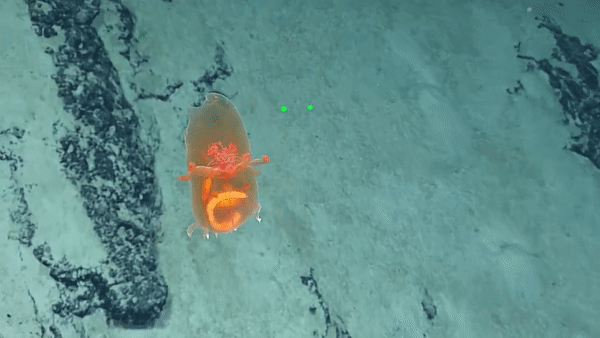Alien shopping-bag ocean weirdo has glowing Cheetos for guts
The deep-sea creature surprised scientists.

Resembling an alien shopping bag with guts made of glowing Cheetos, a bizarre creature took center stage in new footage captured by a remotely operated vehicle deep in the Pacific Ocean.
Gliding through the sea at a depth of some 7,221 feet (2,201 meters), the ocean weirdo — actually an unknown species of sea cucumber — had its innards on display in the new clip, taken in March by an ROV exploring part of the Pacific Remote Islands Marine National Monument southeast of Honolulu. The ROV was gliding over an unexplored seamount at the Kingman Reef and Palmyra Atoll when operators spotted the creature, said Megan Cook, the director of education and outreach at The Ocean Exploration Trust's Nautilus Live.
"These are always so exciting and spectacular to see because — just, what an incredible animal," Cook told Live Science.
Sea cucumbers, or holothurians, are a diverse group, with many species distributed across the Central Pacific, Cook said. The one spotted by the ROV linked to the research vessel E/V Nautilus crew belongs to a family called Elpidiidae, she said. These deep-sea cucumbers are scavengers that feed on marine snow, a shower of skin cells, poop and bits of dead animals that filters down to the ocean floor.
Related: 10 weird creatures found in the deep sea in 2021
Many species in the Elpidiidae family have appendages that look like fins or sails that let them swim for short distances. This is a useful adaptation that allows the sea cucumbers to cover more ground and search for new grazing spots, Cook said.
To eat, the animal oozes across the seafloor, using its sticky tentacles — the leaf- or star-shaped red fringe around its mouth — to pick up a mix of sand and organic material, which it then brings to its mouth. The bright orange intestine — the glowing "Cheetos" — seen inside the transparent creature then digests the organic material, excreting the non-edible sand.
Sign up for the Live Science daily newsletter now
Get the world’s most fascinating discoveries delivered straight to your inbox.
This turns out to be an important storage system for carbon. The ocean floor is the largest carbon sequestration system on Earth, with carbon-rich organic material getting scooped up by bottom-dwellers like sea cucumbers and remaining deep in the ocean for long periods of time.
"They are this great scavenger/recycler on the seafloor," Cook said of the deep-sea sea cucumbers.
Some sea cucumber species can eject their digestive systems through their anuses when startled, a method that often lets them escape hungry predators. (The organs soon grow back.) However, it's unknown if the species in the new video has that trick up its sleeve (or its anus), Cook said.
The EV Nautilus livestreams its ROV dives, and the current season runs through late October. The team will continue to explore the Central Pacific, including many unexplored spots in the Pacific Remote Islands Marine National Monument and its surroundings. Viewers can follow along on Twitter @EVNautilus, on Instagram at @NautilusLive, on TikTok @NautilusLive, on Facebook @NautilusLive or on YouTube at /EVNautilus.
"Our next ROV dives will be to Johnston Atoll, which is one of the most remote atolls in the whole planet," Cook said.
Originally published on Live Science.

Stephanie Pappas is a contributing writer for Live Science, covering topics ranging from geoscience to archaeology to the human brain and behavior. She was previously a senior writer for Live Science but is now a freelancer based in Denver, Colorado, and regularly contributes to Scientific American and The Monitor, the monthly magazine of the American Psychological Association. Stephanie received a bachelor's degree in psychology from the University of South Carolina and a graduate certificate in science communication from the University of California, Santa Cruz.









